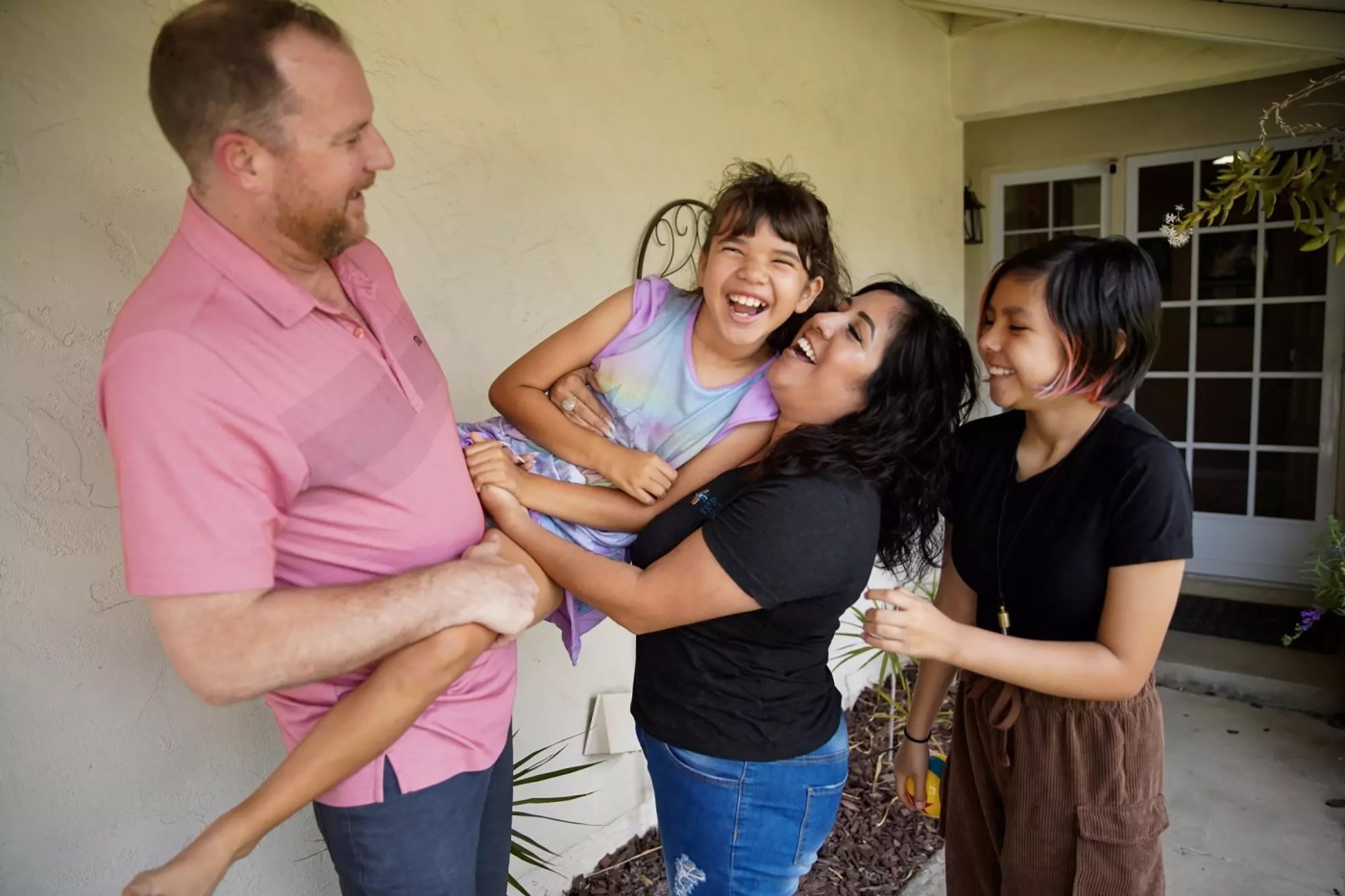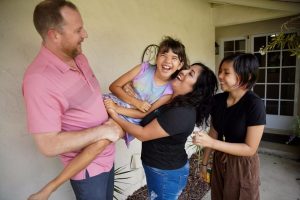
Solving the puzzle: Autism diagnosis often takes longer for girls, whose symptoms can differ from boys’
Lauren J. Mapp | The San Diego Union-Tribune (TNS)
SAN DIEGO — Donning one of her favorite unicorn-themed nightgowns and perched comfortably in an extra large beanbag chair, Alyssa Tracy watches videos on her tablet.
It’s a quiet, early April morning at the Lakeside, California, home where the 10-year-old lives with her parents, Dustin and Debra Tracy, and older sister Grace Tracy, age 12.
But just a few minutes earlier, Alyssa was a little fussy. Being on spring break means her school routine is disrupted. Plus, there’s a reporter and photographer visiting.
Alyssa Tracy, 10, engages with an activity on her tablet at home. In some cases, an autism diagnosis is delayed because girls may be seen merely as quieter or shy, rather than demonstrating clear symptoms. Research over the past decade has helped reveal that boys and girls may present symptoms in different ways. (Alejandro Tamayo/The San Diego Union-Tribune/TNS)
Having a stable routine can be really important for children like Alyssa, who is diagnosed with autism spectrum disorder.
“Her hair, her routine, it always has to be done a certain way,” said her mom. “She has to have ponytails every day. It can’t be braids. It used to be braids for a while, for a few years. But now it’s just ponytails.”
Autism spectrum disorder is a developmental disorder, characterized by difficulty with communication, social interactions and behavior, the Centers for Disease Control and Prevention reports.
Some early signs of autism are when a child fails to make or keep eye contact or if they don’t respond to their name by the time they’re 9 months old. They may also seem unaware when someone speaks to them. At a year old, they might use few or no gestures — such as not waving goodbye — and they may not play simple games, like pat-a-cake.
While Alyssa was diagnosed with autism at age 2 — under the average diagnosis age of 4½, according to the CDC — many other girls and women with the condition are not diagnosed until much later than their male counterparts. That latent diagnosis can impact when or if they receive support therapies, which experts says are key to improved long-term outcomes.
Gender-based differences in autism
The Organization for Autism Research reports that while 25 percent of boys with autism are diagnosed before age 6, only 8 percent of girls receive a diagnosis by that time. By 11 years old, about half of boys have been diagnosed, compared with 20 percent of girls.
UCLA Health reports that nearly 80 percent of autistic women are undiagnosed at age 18.
Among those not diagnosed until adulthood is Jennifer Cook, author of the memoir“Autism in Heels” and nine other books about autism. Her virtual coaching for neurodiverse people is featured on the Netflix series “Love on the Spectrum U.S.,” which was renewed for a third season earlier this month.
In 2011, Cook was identified as being on the spectrum at 35, after her three children were diagnosed. At the time, some of the specialists working with her daughter, then 7, would ask questions about why Cook was using specific methods during home school lessons.
After several specialists asked similar questions, Cook started to question whether she, too, had autism spectrum disorder. But at the time, she couldn’t find information about what autism looked like in women and girls.
So, Cook listed how she thought the condition showed up in her life, “Chicklist Check List,” which she later published in her memoir. She brought it to her therapist, who agreed with her self-assessment.
She said that while getting a diagnosis can be self-affirming, people shouldn’t think it in any way limits who they are and what they are capable of.
“I went to two Ivy League schools, I was the social chair for my sorority and a college cheerleader,” Cook said. “I don’t fit the bill of what a stereotypical autistic person looks like and I think that’s cool.”
Why fewer girls and women get diagnosed early
There are several reasons that may cause a gender-based disparity.
Because a lot of autism research has historically focused on males, the diagnostic criteria has long been based on how they experience the condition. That has led to biases in screening practices, leading to girls and women being less likely to be identified.
“It’s really in the last decade or so that we have been trying to get better at looking at some of the differences between girls and boys in terms of their presentation,” Yanan Guo said.
Related Articles
States want to make it harder for health insurers to deny care, but firms might evade enforcement
‘Are nursing homes our only option?’ These centers offer older adults an alternative
Sugar cravings could be caused by loneliness, study finds
When rogue brokers switch people’s ACA policies, tax surprises can follow
Emergency rooms refused to treat pregnant women, leaving one to miscarry in a lobby restroom
She is a licensed clinical psychologist at the Developmental Evaluation Clinic with Rady Children’s Hospital and board-certified behavior analyst who specialized in autism spectrum disorder before starting her doctorate.
One way autism can differ between genders is that autistic girls can sometimes present as being more social. They also might be quiet and less disruptive, meaning they might not be perceived as needing additional services, said Doris Trauner, Department of Neurosciences professor emerita at UC San Diego School of Medicine.
There are also cultural biases at play.
“If a 3- or 4-year-old girl doesn’t want to talk to anybody else, kind of hides behind her mother or wants to look at books instead of talking to people, they are described as shy,” Trauner said. “If a boy wants to do that, that’s sometimes deemed to be more concerning because boys are supposed to be running around and playing with other kids.”
Girls and women with autism are more likely to employ camouflaging strategies, masking their symptoms by imitating neurotypical social behaviors. This adaptive technique allows them to blend in with their peers, often leading to difficulties in receiving an accurate or early diagnosis.
“Even though they do these things, they’re not necessarily understanding the nuance of the more subtle things that are included in these social relationships,” Guo said.
Big sister Grace Tracy, 12, speaks to a reporter at the family’s Lakeside home. (Alejandro Tamayo/The San Diego Union-Tribune/TNS)
This coping mechanism, aimed at fitting in, can also lead to increased mental health challenges for autistic girls and women.
“It’s very stressful for somebody to do that because they’re not being themselves, and so that may actually end up resulting in more behavior problems because of the stress and anxiety,” Trauner said.
Camouflaging can also lead to someone being misdiagnosed. Some common diagnoses girls and women with autism receive include borderline personality disorder, eating disorders, Tourette syndrome, bipolar disorder, social anxiety disorder or generalized anxiety disorder, the Autistic Women & Nonbinary Network reports.
“I’ll see kids who come with a diagnosis of anxiety disorder, oppositional defiant disorder, attention deficit disorder, obsessive compulsive disorder, one kid with four or five different diagnoses,” Trauner said. “It turns out when you put it all together, they meet criteria for autism.”
Getting connected to autism resources
Researchers say early diagnosis is imperative because the therapies to support children with autism are most effective when they receive those resources before they’re 3 years old.
Speech therapy for children with autism focuses on improving communication skills, occupational therapy enhances everyday functional abilities and independence, and behavioral therapy helps manage behaviors, developing coping strategies for social interaction and emotional regulation.
All three can play important roles in supporting people with autism, fostering their communication skills, independence and emotional well-being.
These therapies provide tailored support, recognizing the unique strengths and challenges of each person, and empowering them to navigate the world with confidence and autonomy. By focusing on holistic approaches and respecting the diverse abilities of people with autism, these therapies promote inclusivity and ensure that everyone has the opportunity to thrive.
Alyssa Tracy, who is on the autism spectrum, plays on her tablet during spring break while her father, Dustin, offers help. Dustin Tracy points out that they were fortunate that their primary care physician understood autism. It meant they could start the intervention process sooner rather than later. (Alejandro Tamayo/The San Diego Union-Tribune/TNS)
Having an early diagnosis helps families learn what support is available and can help them gain access to the services, especially if there are long wait lists for programs.
“You have to keep advocating for your children to make sure that they get what they need,” Guo said.
Dustin Tracy said that his older daughter, who does not have autism, had worked with a speech therapist when she was young because she had a minor speech delay. When Alyssa was experiencing delayed speech a few years later, he and his wife initially thought that she was following in Grace’s footsteps.
By the time Alyssa was about 18 months old, she was using about 20 to 30 words, but became nonspeaking by the time she turned 2. That’s when the Tracys brought Alyssa to her primary care physician, who screened and diagnosed her with autism.
“We were really fortunate that our primary care physician understood autism because not all of them do, especially when it comes to recognizing those symptoms in women,” Dustin Taylor said.
The San Diego Regional Center— which reports that about 40 percent of clients have autism — supports individuals with intellectual or developmental disabilities and their families from birth throughout their lives. The center is the local coordinator of the California Early Start Program, which ensures that eligible infants and toddlers receive evaluation and support services.
Parents can also work with their child’s school to start the process of receiving an Individualized Education Program, a personalized plan tailored to their unique strengths and challenges.
In some cases, parents may also qualify to be paid for the care they provide their children through the county’s In-Home Supportive Services. Debra Tracy said that because she may need to pick up Alyssa from school at a moment’s notice if an issue arises, working a job outside the home is not possible at this time.
“I’ve always been a very independent woman, so being able to say that I’m providing for my family, it’s a big thing,” she said.
Because his daughter was so young when she was diagnosed, Dustin Tracy said they were able to get Alyssa connected to resources through the San Diego Regional Center and the Autism Society San Diego, the latter of which he’s the treasurer. Alyssa received early intervention services for speech therapy and occupational therapy, and her mom and dad were able to learn from other parents in local support groups.
Alyssa continues to work with specialists, which Dustin Tracy said contributed to the success of a recent vacation to Hawaii.
“We never thought we could travel with her or anything like that just based on early experience and her behaviors,” he said. “We were able to get on the plane, go out for a week and have an incredible time in a place we never thought we’d visit together and really enjoy ourselves.”
©2024 The San Diego Union-Tribune. Visit sandiegouniontribune.com. Distributed by Tribune Content Agency, LLC.


